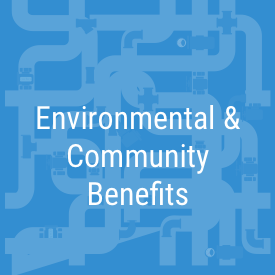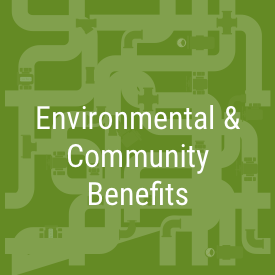At Valley Water, we are working to protect our community’s drinking water, keep residents and businesses safe from flooding and natural disasters, repair and replace aging dams, reservoirs and pipelines, while reducing toxins, hazards and contaminants in our waterways.
Anderson Reservoir is currently limited to about 3% of its capacity due to seismic concerns (see News and Updates tab below for current operating capacity), costing Santa Clara County valuable drinking water resources. This project covers earthquake retrofitting of Anderson Dam to improve reliability and safety, and returns the reservoir to its original storage capacity.
See our video about the Anderson Dam Seismic Retrofit Project








Public meeting scheduled for June 2024
Valley Water invites you to an upcoming public meeting on the Anderson Dam Seismic Retrofit Project. Staff will be providing updates on the project as well as the environmental review process.
When: Thursday, June 6, 2024, 6:30 p.m. – 8:00 p.m.
Where: Morgan Hill Community and Cultural Center Hiram Room
1770 Monterey Road, Morgan Hill, CA 95037
Zoom Link: https://valleywater.zoom.us/j/82910857372
Take a tour of the Anderson Dam and Tunnel Project
What's going on at Anderson?
Our largest water reservoir has been drained while we retrofit it to withstand a large earthquake. Learn more about the project's timeline and how our region can benefit from a reconstructed Anderson Dam.
Anderson Dam Tunnel Project Groundbreaking Ceremony
On July 7, 2021, Valley Water held a groundbreaking ceremony for the Anderson Dam Tunnel project. To view the ceremony recording, please see below for the video links.
Alternate recreational areas
While the Anderson Dam Tunnel Project is under construction, large portions of the Anderson Lake County Park will remain open, including the Live Oak Picnic area, the Rosendin area, the Anderson Lake Park Visitor Center and the Coyote Creek Parkway. However, some areas of the park will be closed, impacting recreational activities such as angling, boating, hiking and picnicking around the dam and reservoir. These activities will be limited or completely closed.
During construction, please check out these alternative recreational spots nearby:
- Coyote Lake Harvey Bear Ranch County Park. Located just upstream of Anderson Reservoir, the park provides power and non-power boating, fishing, hiking, picnicking, nature trails, camping and biking opportunities around Valley Water's Coyote Reservoir.
- Calero County Park. Boating, fishing, hiking and picnicking is available. The park surrounds the nearby Calero Reservoir.
- Henry Coe State Park. Located about three miles east of Anderson Reservoir, the park is the largest state park in northern California. It protects and preserves 87,000 acres of scenic hills and mountain ridges in the Diablo Mountain Ridge. The largely undeveloped park welcomes backpackers, equestrians, mountain bikers, day hikers and anyone seeking solitude in a nearly untouched setting.
- Coyote Valley Open Space Preserve. This preserve offers a scenic overlook from the western edge of the Coyote Valley in addition to multi-use trails and picnicking areas.
- Rancho Canada del Oro Open Space Preserve. Located in the foothills of the Santa Cruz mountains in South Santa Clara County, the preserve has 12 miles of easy to challenging trails. The multi-use trails are open to hikers, mountain bikers and equestrians.
For a listing of city parks and trails in Morgan Trails, visit the Parks and Open Space page on the city of Morgan Hill's web site.
Lowering of Anderson Reservoir
Valley Water began lowering water levels in Anderson Reservoir on Oct. 1, 2020, to comply with an order from the Federal Energy Regulatory Commission (FERC). In mid-December 2020, water levels in Anderson Reservoir were lowered to 3% of capacity, the lowest level that can be reached through the existing outlet tunnel.
Valley Water’s 42-page draining plan can be found here. The plan includes building a 1,700-foot-long tunnel, up to 24-feet in diameter, on the left side of the dam looking towards the reservoir. The new tunnel will increase Valley Water’s ability to release water from the reservoir during an emergency by five-fold.
Read more about your water supply questions here and here.
Did you miss any of our public meetings?
Valley Water videos each of its meetings, virtual and the ones in person. The public can view the meetings through Valley Water’s You Tube channel.
- Oct. 4, 2023 - Presentation on the Draft Environmental Impact Report.
- May 24, 2023: Progress of the Anderson Dam Seismic Retrofit and Tunnel projects.
- May 19, 2021: Anderson Dam Tunnel Project Pre-construction Meeting
- Feb. 18, 2021: Borello Ranch Estates and Alicante Ranch
- Sept. 17, 2020: Anderson Reservoir Dewatering and Tunnel Project Virtual Public Meeting
- Sept. 9, 2020: Holiday Lake Estates Virtual Public Meeting
- May 28, 2020: Anderson Dam Retrofit Project Virtual Meeting
- April 10, 2019: Anderson Dam Retrofit Project Public Meeting at the Morgan Hill Community Center.
- Oct. 24, 2018: Anderson Dam Retrofit Project Public Meeting at the Morgan Hill Community Center.
- June 4, 2018:Anderson Dam Retrofit Project Public Meeting at the Morgan Hill Community Center.
- Sept. 13, 2017: Anderson Dam Retrofit Project Public Meeting at the Morgan Hill Community Center
Updated April 2024
Informational materials:
- Public Notice for Plan Distribution - Hoot Owl Way
- Valley Water Draft Relocation Plan Hoot Owl
- Anderson Dam Seismic Retrofit Project FAQ - January 2022
- Anderson Dam Water Supply FAQ
- FERC Order Dam Safety Directives
- FERC Order Compliance Project - Engineers Report - June 2020
- Anderson Dam Project Shell - May 2020
- Anderson Project FAQ - March 2020
- Anderson Dam Neighborhood Update - March 2019
- Anderson Dam Seismic Retrofit Project Fact Sheet
- Notice of Preparation and Initial Study
- Anderson Dam Planning Study Report
- Q&A from September 9th and 17th Virtual Public Meetings
Anderson Dam Draft Environmental Impact Report Virtual Meeting Materials October 4, 2023
Anderson Dam Virtual Meeting Materials February 18, 2021
Anderson Dam Virtual Meeting Materials September 17, 2020
Anderson Dam Virtual Meeting Materials May 28, 2020
Materials from Past Anderson Dam Seismic Retrofit Public Meetings
Materials from Community Update Meeting Wednesday, April 10, 2019:
Materials from Community Update Meeting Monday, June 4, 2018:
Materials from Community Update Meeting, Wednesday, October 24, 2018:
Materials from Community Update Meeting Wednesday, Sept. 13, 2017:
- Agenda
- Project Description
- Updated Project FAQ
- PowerPoint Presentation (PDF)
- Construction Sequence animation (PPT)
- Click here to view a video of the meeting
Materials from the Anderson Dam Seismic Retrofit Project
Public Meeting on March 22, 2017:
FY22-36 Key Performance Indicator for the Safe, Clean Water Program
-
Provide portion of funds, up to $54.1 million, to help restore full operating reservoir capacity of 90,373 acre-feet.
Benefits
-
Brings the dam into compliance with today’s seismic standards
-
Increases reliability and safety of our area’s largest reservoir by protecting it from earthquakes
-
Eliminates operational restrictions issued by the two regulatory agencies—the Federal Energy Regulatory Commission (FERC) and the California Department of Water Resources Division of Safety of Dams (DSOD). In February 2020, FERC directed Valley Water to begin safely lowering the reservoir to an elevation of 488 feet (essentially almost emptying the reservoir) beginning October 1, 2020. This project would restore Anderson
Reservoir to its full capacity of approximately 90,373 acre-feet of water storage for our current and future water supply -
Ensures compliance with environmental laws and regulations
-
Enhances native fish and wildlife habitat
-
Minimizes the risk of uncontrollable releases from the reservoir, which could cause downstream flooding
Geographic Area of Benefit
Countywide
Anderson Dam creates the county’s largest surface water reservoir—Anderson Reservoir— which stores local rainfall runoff and imported water from the Central Valley Project. The reservoir is an important water source for treatment plants and the recharge of the groundwater basin. Besides restoring drinking water supplies, the upgrade also supports compliance with environmental regulations. Valley Water’s regular reservoir releases ensure that downstream habitat has healthy flows and temperatures to sustain wildlife.
A breach of Anderson Dam at full capacity could have catastrophic consequences, including inundation of surrounding land more than 30 miles northwest to San Francisco Bay, and more than 40 miles southeast to Monterey Bay.
In December 2016, the Board was informed by Valley Water staff that findings from the geotechnical and geologic investigations performed during the project’s design phase led to the conclusion that a more extensive dam retrofit than had originally been envisioned would have to be performed. Further, the Board was informed that the more extensive retrofit work would double the previous project’s estimated cost. Valley Water staff presented the Board with a water supply cost-benefit analysis that showed the benefits of the more extensive retrofit project significantly outweighed the cost of not proceeding with the retrofit, which would require Valley Water to purchase additional imported water every year to make up for the loss of long-term storage at Anderson Reservoir. Based upon this information and analysis, the Board directed Valley Water to continue work on this critical infrastructure project.
Anderson Reservoir is the largest of the 10 Valley Water reservoirs and provides a reliable supply of water to Santa Clara County. It has a total storage capacity of approximately 90,000 acre-feet (one acre-foot is 325,851 gallons of water, enough to serve two households of five for one year). Anderson Dam was built in 1950 and named after the key founder and first president of Valley Water, Leroy Anderson. A long, deep natural gorge located three miles east of U.S. 101 in Morgan Hill provided a suitable dam site.
Findings of the original seismic stability evaluation completed in 2011 on Anderson Dam indicated that the downstream and upstream embankments could become unstable during a very large magnitude earthquake and the rupture of faults underlying the dam may have adverse impact on the outlet pipe and intake structure.
About the Safe, Clean Water and Natural Flood Protection Program
In November 2020, voters in Santa Clara County overwhelmingly approved Measure S, a renewal of Valley Water’s Safe, Clean Water and Natural Flood Protection Program.
The program was first passed by voters in 2000 as the Clean, Safe Creeks and Natural Flood Protection Plan, then again in 2012 as the Safe, Clean Water and Natural Flood Protection Program. The renewal of the Safe, Clean Water Program will continue to provide approximately $47 million annually for local projects that deliver safe, clean water, natural flood protection, and environmental stewardship to all the communities we serve in Santa Clara County.
While evaluating ways to improve the 2012 program, Valley Water gathered feedback from more than 21,000 community members. That helped Valley Water create the six priorities for the renewed Safe, Clean Water Program, which are:
Priority A: Ensure a Safe, Reliable Water Supply
Priority B: Reduce Toxins, Hazards and Contaminants in our Waterways
Priority C: Protect our Water Supply and Dams from Earthquakes and Other Natural Disasters
Priority D: Restore Wildlife Habitat and Provide Open Space
Priority E: Provide Flood Protection to Homes, Businesses, Schools, Streets and Highways
Priority F: Support Public Health and Public Safety for Our Community
Each year, Valley Water prepares a report providing a progress update for each of these program priorities, along with fiscal year accomplishments.
To ensure transparency and accountability to the voters, the ballot measure also created an Independent Monitoring Committee, appointed by the Santa Clara Valley Water District Board of Directors. The Independent Monitoring Committee annually reviews the program’s progress to ensure the outcomes are achieved in a cost-efficient manner and reports its findings to the Board. Additionally, the IMC also reviews each proposed 5-year implementation plan prior to its submittal for Board approval.
In addition, the program requires three independent audits.


